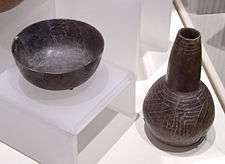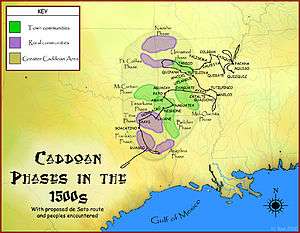Caddoan Mississippian culture

The Caddoan Mississippian culture was a prehistoric Native American culture considered by archaeologists as a variant of the Mississippian culture.[1] The Caddoan Mississippians covered a large territory, including what is now Eastern Oklahoma, Western Arkansas, Northeast Texas, and Northwest Louisiana. Archaeological evidence that the cultural continuity is unbroken from prehistory to the present; that the direct ancestors of the modern Caddo Nation of Oklahoma included the speakers of the Caddo and related Caddo language in prehistoric times and at first European contact, is unquestioned today.[2]
Description
Development
The Caddoan Mississippians are thought to be an extension of Woodland period peoples, the Fourche Maline culture and Mossy Grove culture peoples who were living in the area around 200 BCE to 800 CE.[3] They were linked to other peoples across much of the Eastern Woodlands through trade networks. This time period saw the introduction of pottery making from peoples to their east, and by 500 CE the bow and arrow from the Southwest. By 800 CE early Caddoan society began to coalesce into one of the earlier Mississippian cultures. Some villages began to gain prominence as ritual centers, with elite residences and temple mound constructions. The mounds were arranged around open plazas, which were usually kept swept clean and were often used for ceremonial occasions. As complex religious and social ideas developed, some people and family lineages gained prominence over others. This hierarchical structure is marked in the archaeological record by the appearance of large tombs with exotic grave offerings of obvious symbols of authority and prestige.[3]

By 1000 CE a society defined as "Caddoan" had emerged. Major sites such as Spiro and the Battle Mound Site are in the Arkansas River Valley and the Red River Valley, respectively, these valleys being the largest and most fertile areas in the Caddoan region, where maize agriculture would have been the most productive.[4] The Caddoans had developed a distinct type of pottery making, later described by the de Soto expedition as some of the finest they had seen, even in their European homeland. By 1200, the numerous villages, hamlets, and farmsteads established throughout the Caddo world had begun extensive maize agriculture.[3]
Recent excavations have revealed more cultural diversity within the region than had been expected by scholars, particularly in sites along the Arkansas River. Caddoan Mississippian towns had a more irregular layout of earthen mounds and associated villages than did towns in the Middle Mississippian heartland to the east. They also lacked the wooden palisade fortifications often found in the major Middle Mississippian towns. Living on the western edge of the Mississippian world, the Caddoans may have faced fewer military threats from their neighbors. Their societies may also have had a somewhat lower level of social stratification. The location of the western edge of the Eastern Woodlands may account for these differences. The climate west of the woodlands was drier, hindering maize production, and the lower population on the plains to the west may have meant fewer neighboring chiefdoms with whom to compete and contend.[4]
However, around 1400 CE, Caddoan populations had peaked, with many ritual centers beginning to decline in population. A more dispersed settlement system developed, with the bulk of the people living on dispersed homesteads and farms rather than in large villages. By this time the earlier broad cultural unity began to break down, with many distinct local variations developing.[3]
Trade

Caddoan Mississippian peoples were connected to the larger Mississippian world to the east and other cultures to the southwest by trade networks which spanned the North American continent. Artifacts found in "The Great Mortuary" (Craig Mound) at the Spiro site included wood, conch shell, copper, basketry, woven fabric, lace, fur, feathers, and carved stone statues. Some artifacts came from as far away as Cahokia in Illinois, Etowah and Ocmulgee in Georgia, and Moundville in Alabama. Many featured the elaborate symbolism of the Southeastern Ceremonial Complex, a multiregional and pan-linguistic trade and religious network. Exotic material found at Caddoan Mississippian sites included colored flint from New Mexico, copper from the Great Lakes, conch (or lightning whelk) shells from the Gulf Coast, and mica from the Carolinas.[5] The Spiro site is the only Mississippian site to produce an artifact from Mesoamerica, a piece of black obsidian from Mexico, probably through trade with peoples to the southwest.[6] Using these valued materials, Mississippian artists created exquisite works of art reflecting their cultural identity and their complex spiritual beliefs.
Language
The Caddoan Mississippians were speakers of the many Caddoan languages.[2] The Caddoan languages once had a broad geographic distribution, but many are now extinct. The modern languages in the Caddoan family include Caddo and Pawnee. Both are now spoken mainly by tribal elders.
Sites
| Site | Image | Description |
|---|---|---|
| Battle Mound Site | Located in Lafayette County, Arkansas in the Great Bend region of the Red River basin and has the largest mound of the Caddoan Mississippian culture | |
| Belcher Mound Site | Located in Caddo Parish, Louisiana[7] in the Red River Valley 20 miles north of Shreveport[8] and about one-half mile east of the town of Belcher, Louisiana[9] | |
| Bluffton Mound Site | Located in Yell County, Arkansas on the Fourche La Fave River.[10] | |
| Caddoan Mounds State Historic Site | Also known as the George C. Davis Site (41CE19), located in Cherokee County, Texas 26 miles west of Nacogdoches, Texas on Texas State Highway 21 near its intersection with U.S. Route 69 in the Piney Woods region of east Texas | |
| Gahagan Mounds Site | Located in Red River Parish, Louisiana[11] in the Red River Valley | |
| Spiro Mounds |  |
One of the best-studied archaeological centers of Mississippian culture; located in Eastern Oklahoma in Le Flore County near the modern town of Spiro |
European contact

When the Spanish conquistador Hernando de Soto led an expedition into what is now the southeastern United States in the 1540s, he encountered Native American groups recorded as the Naguatex, Nishone, Hacanac, and Nondacao. They are now believed to be Caddo villages. It is estimated that in 1520, the many tribes of people numbered about 250,000.[12] Over the next 250 years the population of these Caddoan-speaking peoples was severely reduced by epidemics of diseases inadvertently brought by Spanish and French coming to the Americas and spread by indigenous trading networks. Sometimes after the coming of the Europeans, the Caddo would organize into three confederacies—the Natchitoches, Hasinai, and the Kadohadacho, but all Caddoans were all linked together by a common language.
Caddo today
The Caddo Nation of Oklahoma (previously known as the Caddo Tribe of Oklahoma) is a federally recognized tribe. A tribal constitution provides for a tribal council consisting of eight members with a chairperson, based in Binger, Oklahoma.[13] The tribal complex, dance grounds, and the Caddo Heritage Museum are located south of Binger. 5000 people are enrolled in the tribe, with 2500 living within the state of Oklahoma. The tribe operates its own housing authority and issues its own tribal vehicle tags.[14] They maintain administrative centers, dance grounds, several community centers, and an active NAGPRA office.
Several programs exist to invigorate Caddo traditions. The tribe sponsors a summer culture camp for children.[15] The Hasinai Society[16] and Caddo Culture Club[17] both keep Caddo songs and dances alive, while the Kiwat Hasinay Foundation is dedicated to preserving the Caddo language.[18]
See also
References
- ↑ Peregrine, Peter N. (1995). Archaeology of the Mississippian culture: a research guide. Garland Publishing. p. 165. ISBN 978-0-8153-0336-7.
- 1 2 "Tejas-Caddo Fundamentals-Caddoan Languages and Peoples". Retrieved 2010-02-04.
- 1 2 3 4 "Tejas-Caddo Fundamentals-Caddo Timeline". Retrieved 2010-02-04.
- 1 2 "Tejas-Caddo Fundamentals-Mississippian World". Retrieved 2010-02-04.
- ↑ "Spiro Mounds-A Ceremonial Center of the Southern Cult". Retrieved 8 September 2013.
- ↑ Pauketat, Timothy R. (2004). Ancient Cahokia and the Mississippians. Cambridge University Press. ISBN 978-0-521-52066-9.
- ↑ "Locality information for Faunmap locality Belcher Mound, LA". Retrieved 2010-02-22.
- ↑ "The Caddo Indians of Louisiana". Retrieved 2010-02-22.
- ↑ "Historical-Belcher". Retrieved 2010-02-22.
- ↑ "History of the Ouachita Mountains". Retrieved 2010-02-23.
- ↑ "Notice of Inventory Completion for Native American Human Remains and Associated Funerary Objects in the Possession of the Louisiana State University Museum". Retrieved 2010-02-22.
- ↑ Juliana Barr, Peace Came in the Form of a Woman: Indians and Spaniards in the Texas Borderlands (Chapel Hill: University of North Carolina Press, 2007) p. 20
- ↑ Constitution and By-Laws of the Caddo Indian Tribe of Oklahoma. National Tribal Justice Resource Center. (retrieved 13 September 2009)
- ↑ Oklahoma Indian Affairs Commission. 2008 Pocket Pictorial Archived April 6, 2010, at the Wayback Machine.. Page 5 (retrieved 13 Sept 2009)
- ↑ Hasinai Summer Youth Camp. Hasinai Society. 2008 (retrieved 13 Sept 2009)
- ↑ General Information. Hasinai Society. 2008 (retrieved 13 Sept 2009)
- ↑ Edge, Donald. Caddo Culture Club. Caddo Nation: Heritage and Culture. (retrieved 13 Sept 2009)
- ↑ Background. Kiwat Hasinay Foundation.(retrieved 13 Sept 2009)
External links
| Wikimedia Commons has media related to Mississippian culture. |
| Wikimedia Commons has media related to Caddo. |
- Caddoan Mounds State Historic Site
- The Encyclopedia of Arkansas History and Culture (The Caddo Indians)
- The Encyclopedia of Arkansas History and Culture (Indian Mounds)
- A History of the Caddo Indians
- THE CADDO MOUNDBUILDER'S LEGACY
- The Norman Mound Site
- The Harlan Mound Site
- Caddo Archaeology
- Caddoan Archaeology Newsletter

